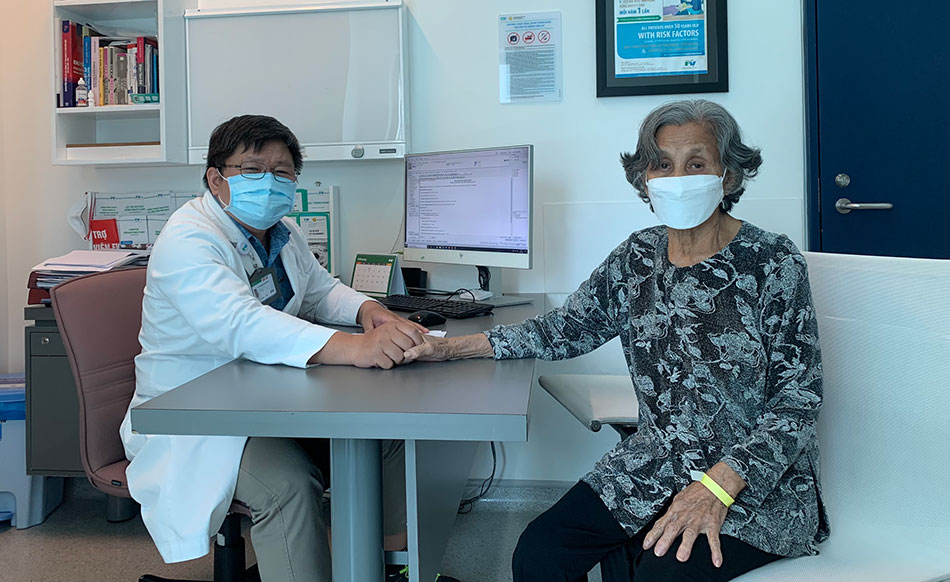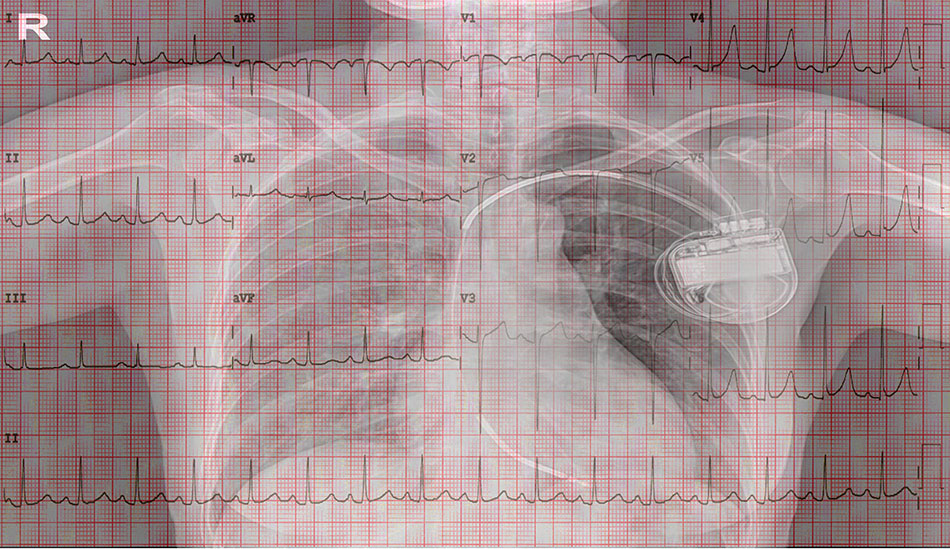A 83-year-old female patient NTN, from Dong Nai, came to the FV Cardiology Department with feeling lightheaded and dizzy. The patient was examined by Dr Hoang Quang Minh who after ordering the necessary tests and investigations such as: brain MRI, trans-thoracic echocardiography, resting echocardiogram, 24-hour electrocardiogram using a Holter machine to monitor heart rate continuously. The results recorded the fastest heart rate was 75 beats/minute and bradycardia (less than 60 beats/minute) that accounted for 80% of the monitoring time. Dr Hoang Quang Minh suspected a problem with the sinus node, so he gave the patient an extra stress test to determine the heart rate; the results were still not enough to meet the body’s demand for movement.
According to Dr Hoang Quang Minh, a normal heart rhythm is generated by the sinus node. If there is a problem with the sinus node, the ability for pacing is not as good as before and leads to bradycardia. This manifests when the sinus node is lost or poorly adapted to physiological changes or responding to activities. In a normal person, the sinus node stimulates beats 60-80 times/minute, but during exertion (exercise, sports, etc) the sinus node will respond and emit a faster rhythm, depending on the needs. When the heart rate does not increase enough, the heart beats slowly, the blood will not reach the brain, and the patient may experience symptoms such as dizziness, light-headedness, even fainting. Permanent pacemaker placement is the optimal treatment option when bradycardia in the elderly is accompanied by these symptoms.
In the case of Mrs N, after excluding brain-related diseases, Dr Hoang Quang Minh diagnosed the patient with symptomatic sinus node failure, sinus bradycardia causing inability to regulate heart rhythm which required a permanent pacemaker implantation that responds to and regulates the heart rate.
The procedure is performed at the Cardiac Catheterization (Cathlab), using a modern Philips DSA system with integrated multi-function. In just one hour, with the support of the DSA background digital angiography system, Dr Hoang Quang Minh and his team successfully performed the surgery to place a permanent pacemaker in the patient. After the surgery, the patient felt well, her heart rate improved significantly; she could eat, walk, and she was discharged from the hospital after only five days. When her heart rate was no longer slow, her blood pressure stabilised, her health improved markedly, the patient’s daughter said: ”She was able to walk comfortably on her own, even demanding to go home, but her family won’t let me.”

Patient NTN during the follow-up visit with Doctor Hoang Quang Minh – Senior Doctor, FV Cardiology Department
In particular, the case of Mrs N, when the pacemaker was installed, the fee was also covered by the National Health Insurance paid 68 million VND. “FV was introduced by relatives, I went there, but I didn’t think that my health insurance would cover part of the hospital fees. When I came here, after consultation and guidance from Dr Minh and his friends, I discovered that international standard hospitals also enjoyed this benefit” – the patient’s daughter smiled.
According to Dr Hoang Quang Minh, thanks to the support of the pacemaker, the patient’s heart rate is stable at a minimum of 60 times/minute, helping to minimise the patient’s symptoms and reduce the risk of cardiovascular disease such as heart failure due to bradycardia or memory loss due to decreased cerebral perfusion due to bradycardia. In addition, an outstanding feature of this machine is the ability to change the frequency of pacing pulses, in accordance with the needs of the body in different circumstances. When the patient is active, the machine senses the change of air, thereby increasing the heart rate to ensure circulation, providing enough energy and oxygen for the body.

The patient will be assigned a permanent pacemaker when having bradycardia
Symptomatic bradyarrhythmias are common in the elderly. The disease has a complicated course and there are many different forms of bradycardia. Usually, patients will be assigned a permanent pacemaker when they have bradyarrhythmias (less than 40 beats/minute) or have prolonged sinus arrest. When the sinus node fails, it will no longer obey the commands of the nervous and endocrine systems; thereby causing cardiac arrhythmia, early manifestation is alternating fast and irregular bradycardia. Patients may experience symptoms of feeling slow heartbeat, feeling light-headed, light-headed, light-headed, even fainting, causing trauma, more seriously, heart failure, and sudden cardiac arrest. Therefore, sinus node failure is a very dangerous arrhythmia, which needs to be closely monitored and treated promptly.
From 1st November, 2021, FV Hospital officially cooperated with Ho Chi Minh City Social Insurance to expand the scope of medical examination and treatment by State Health Insurance for high-tech treatment services at FV’s Cardiac Cathlab including:
- Imaging, dilation and stenting of coronary artery, mesenteric artery, renal artery…
- Digital subtraction angiography (DSA)
- Electrophysiological exploration and treatment of arrhythmias with conventional high-frequency waves
- Set up the machine, replace the machine and update the generator
Through this cooperation, patients can be covered by Social Health Insurance provisions for up to 45 per cent of the treatment costs at FV hospital, including the costs of surgery and transplant supplies, medical equipment and consumables.
At the same time, patients can apply parallel types of health insurance, including state health insurance, private health insurance or international health insurance.
When visiting FV hospital for treatment, the patient needs to provide a valid State Health Insurance card, valid ID/Passport and Transfer Document at the medical secretariat counter and will receive instructions specific to their case.



